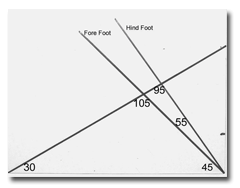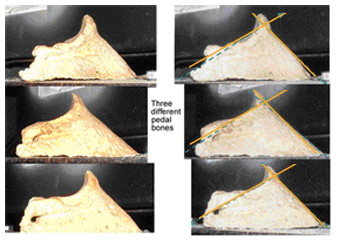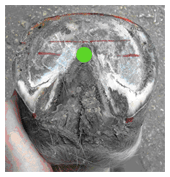We must be able to do better than this!
Article entered for the Jim Gourlay Prize 2005 and subsequently printed in the Veterinary Times Oct 4th 05 Vol 37 No 35
Is it just my clients who don’t have level flat surfaces to satisfactorily radiograph their laminitic pony, and is it just me who finds it difficult to measure the solar angle of a pedal bone from a radiograph? However, is it possible to identify the position of the pedal bone in the foot using Strasser’s plastic sheet?
The plastic sheet is used by lay hoof trimmers following the instructions of Dr Hiltrud Strasser who, as well as other "natural" management techniques, advises that all  horses should be unshod and trimmed with a "ground-parallel pedal bone". This is not the place to debate her ideas but, in my opinion, some are wrong, some maybe correct and others are true and I believe of great significance. (1 & 2)
horses should be unshod and trimmed with a "ground-parallel pedal bone". This is not the place to debate her ideas but, in my opinion, some are wrong, some maybe correct and others are true and I believe of great significance. (1 & 2)
The "Strasser trimmers" use this marked plastic sheet as a template. From one corner there are two lines, 45° representing the dorsal hoof angle of the front foot and 55° the dorsal hoof angle of the hind foot and from the other corner is a line at 30°. This line represents the line of the lateral coronet, taken from the hairline at the heel to the hairline at the toe. It is important that it is taken from these points thus avoiding any curve on the coronary band. What is intriguing is that the angle that the coronet line makes with the line of the dorsal wall is consistently close to 105° whatever the angle the foot is trimmed to. (45° + 30° + 105° = 180° (3)) Most importantly, in a chronic founder horse this angle will be the same at the new horn growth from the coronet before it deviates.

Why should these angles be correct? Pedal bone measurements, taken from radiographs, will give a range of dorsal wall to solar angles, but having tried to take these measurements myself, I found I could make this particular angle virtually anything I wanted depending on which part of the curve on either surface I used to measure. It is easier to measure the angles on pedal bone specimens, taking the solar line as the surface of the object it is placed on, but still there is often a curve on the dorsal surface of the bone. What is most relevant is that the angle made between the proximal portion of the dorsal surface of the pedal bone and a line from the mid point of its articular surface to the lateral processes is also consistently close to 105°.
So how do we use these angles to trim a chronic foundered foot? For all the changes in theories and management techniques put forward over the past thirty years, the one consistent piece of advice has been to lower the heel and to shorten the toe. I do not have to get into the debate about what angle people wish to trim the foot of a foundered horse because, if they use the line of the coronet, they should be able to identify satisfactorily the solar angle before they start and after they finish trimming.

The practical part of the trimming is first to draw a line across the sole, one centimetre back from the true point of the frog (through Duckett’s dot). The heel is trimmed, behind this line only, to the angle that you want.
It is my opinion that the feet of laminitic horses should be trimmed with a ground-parallel pedal bone until stability is achieved, and only after this can the heel can be raised to a more normal angle. If you are aiming for a flat pedal bone then the bottom of the plastic sheet can be used to draw a line on the hoof wall to give you the line of the trim (green), if the 30° line is placed along the coronet (blue).

If we lower the heel of a chronic foundered foot we will further extend the toe. It is as important to shorten this toe as it is to lower the heel, otherwise the leverage from the delayed break-over will continue to cause separation of the weakened laminae pulling the dorsal hoof wall away from the bone. If the 30° line is placed along the coronet (blue), the dorsal wall line will drop down from this at 105° (red), in line at the top but then moving away from this where it has become distorted. The breakover at the toe must be taken back to behind this 105° (red). (The animation below indicates the estimated position of the pedal bone in some examples of chronic foundered feet)
- Strasser H and Kells S (1998) A Lifetime of Soundness
- Strasser H (1999) Shoeing: A Necessary Evil?
- "Assessing the Strasser Method" Journal of Equine Veterinary Science 2004 Laura Florence and Patrick Reilly. (Average of angles of front feet of horses presented to Rochester Equine Clinic 2000 – 2001 were 52.38° + 23.31° + 104.31° = 180°)
- Dave Duckett FWCF Thesis - External Reference Points of the Equine Foot
Alternatively download the original published atricle from my downloads page